Are you experiencing high levels of employee turnover? Low employee engagement is a major factor for low employee retention. Learn how employee engagement and retention are deeply connected to reduce turnover.
Employees are your business’ most valuable resource. But to keep your employees from seeking other opportunities you have to maintain their fulfillment with their work and your business.
Employee engagement is a crucial aspect of your employee retention picture. Engaged employees care about their work and find meaning in it. They enjoy their workplace and get along with coworkers.
We’ll explore the relationship between employee engagement and retention, and provide practical steps for increasing and measuring employee engagement at your company.
See how ContactMonkey’s internal communication solutions help organizations engage their staff.
Take a self-guided tour of ContactMonkey
See how our key features can streamline your internal communications.
Take product tour

What Is Employee Engagement and Retention?
Employee engagement measures how connected your employees are with each other and your business. Their work matters to them and so does their coworkers’ success.
Employee retention is your ability have a lower turnover rate, meaning there are fewer employees leaving for other opportunities. This reduces the need to hire new employees to replace those leaving.
The impact of employee engagement on employee retention is massive. Engaged employees are more likely to remain at your company, and contribute to a stronger company culture.
Employees often leave their jobs because they feel a lack of connection with their role or their coworkers. Weak company culture can make new employees feel excluded from important goings-on at your business, making it more difficult to engage with their work.
Why is employee retention important?
Other than contributing to a solid company culture, employee retention has myriad benefits for your employees and business.
- Save time and money: High levels of employee turnover mean a constant investment into acquiring replacements for leaving employees. Higher employee retention reduces the need for constant employee onboarding and offboarding.
- Retain experienced employees: Fewer employees leaving means more employees gaining experience. Experienced employees can contribute more to your business and are valuable for educating new employees.
- Stronger employee relationships: Employees who work together for longer periods of time have the chance to build solid work relationships with one another. Employees who care about each others’ success have higher levels of employee engagement and contribute to a positive company culture.
- Improved employee experience for new hires: New employees can find it difficult to settle into their new role if people around them are always leaving for other jobs. Seeing other employees staying at your company lets new employees know there are opportunities for development within your organization.
Employee retention can be an excellent barometer for how employees succeed at your business, and if you need to be providing additional benefits or incentives to increase engagement.
But rather than let retention drop before acting, try some of the following strategies for improving employee retention by boosting employee engagement. You can also check out established employee engagement models for ideas for your organization.
Start two-way conversations and employee feedback loops
Learn how to engage staff with pulse surveys, content ratings and reactions, custom polls, and more. Ready to send modern emails?
See engagement features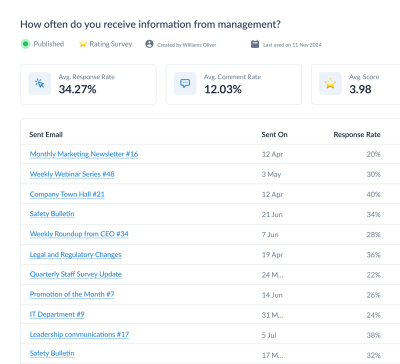
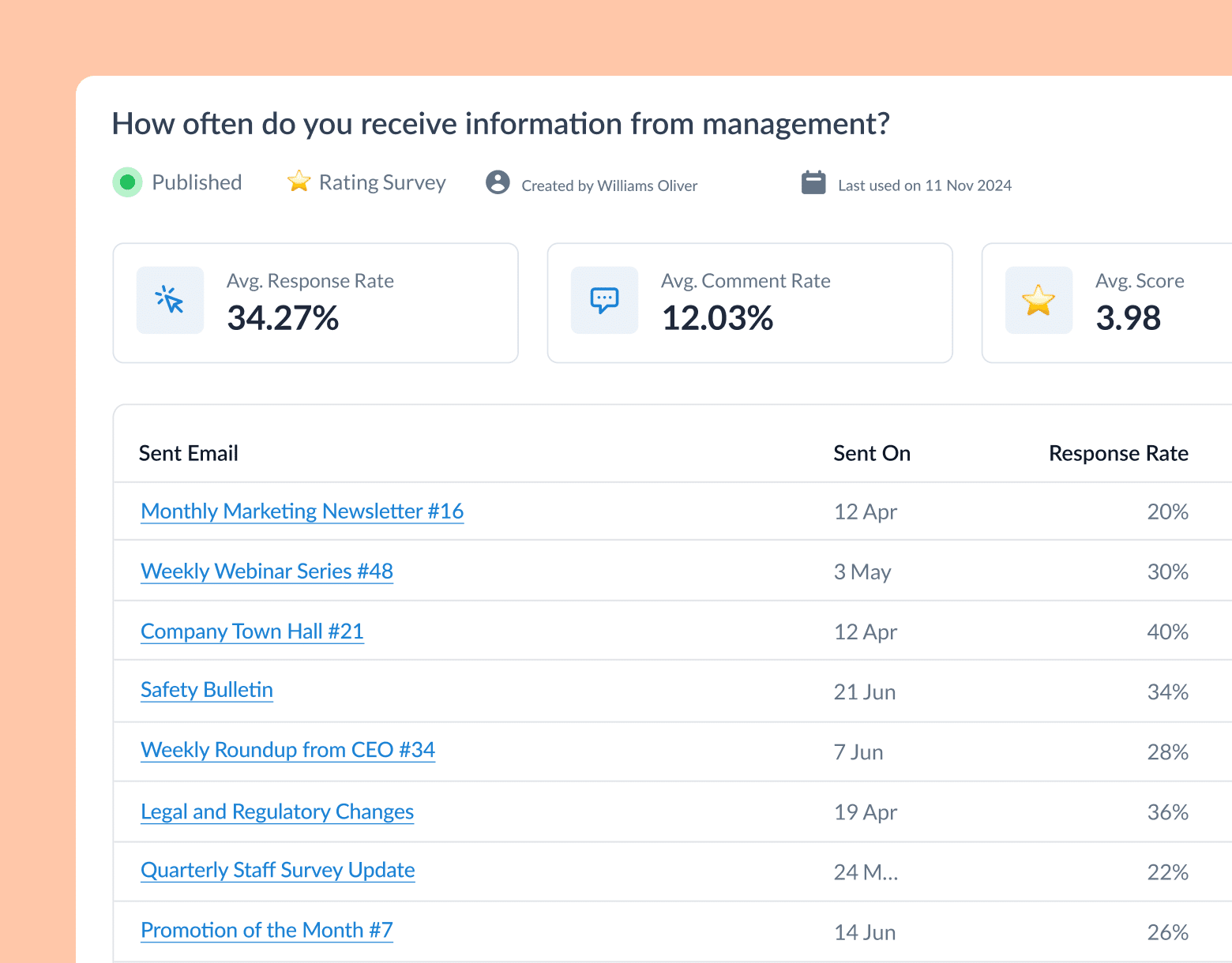
How To Improve Employee Retention via Employee Engagement
Now that you know how employee engagement impacts retention, let’s get into what you can do to increase employee engagement.
Why is employee engagement important? There are many benefits to employee engagement. It touches all kinds of aspects of your business, and we’ll look at specific ways to increase engagement for the benefit of employee retention.
1. Solid onboarding
Help new employees start off on the right foot by creating a comprehensive onboarding program. Ensuring that your new employees are comfortable with their role and coworkers will help them start building engagement immediately.
Try sending out a new employee email to announce the arrival of new employees. This notifies existing employees that someone is new and can prepare them to help them learn if need be. You can also provide handbooks that employees can refer to throughout their employment. Check out our fun employee handbook ideas for useful examples.
Set your employees up for success from the very start by giving them a proper introduction to their coworkers and their role.
2. Positive company culture
A positive company culture goes hand-in-hand with a solid onboarding process. Ideally, your new employees should have:
- Knowledge of your company’s structure to know where to go to ask questions
- Confidence in your workplace culture so that they are not afraid to ask questions if they have any
An open and accepting workplace culture can help ensure that new employees learn what they need to know. It can also help senior employees be more productive as new employees will know exactly who to go to with their questions to avoid unnecessary distractions.
Employee surveys are a fast and easy way to collect feedback on any number of topics. Conduct surveys during your onboarding process to learn your new hires’ expectations, ask company culture survey questions, and compare their results with existing employees to discover gaps in how you engage your employees.
Unlock Internal Comms Superpowers
Discover why 10,000+ rely on us. See the internal email and employee newsletter platform in action.
Book demo

3. Listen to your employees
How can you be sure that your employees are engaged with their work? Try asking them!
Collecting employee feedback is a powerful tool for learning new employee engagement ideas, benefiting both you and your employees.
You get valuable insights into your employees’ experiences, and your employees get to provide their input on issues that matter to them.
Anonymous employee feedback lets your employees give feedback with greater confidence so they can be more candid with their feedback. Collecting anonymous feedback is super easy when you send internal emails with ContactMonkey:
Now you can gain valuable insights into what matters to your employees, just by sending an email. It’s that simple.
Not sure how to write meaningful employee survey questions? Try using ContactMonkey’s OpenAI ChatGPT integration to create unique questions according to your needs. Simply write a prompt describing what you’d like to learn from your survey, and edit the suggested questions according to your audience.
4. Make your employees feel valued
Employees often cite a lack of recognition as a driving factor of a lack of engagement. Make sure you place great importance on your employees’ success, encourage them in their work, and recognize their achievements via fun employee recognition ideas.
Your employees’ success doesn’t just benefit management. Encourage employees to recognize each other when they go above and beyond their expectations. A “shout outs” portion of your company town hall is a great way to let your employees share whose work helped them, particularly in the last month of the quarter.
5. Give employees opportunities
Your employees want to feel like they have chances for promotion within your company. Ensure your employees know that their success matters to the entire organization by prioritizing their professional development.
Collect employee feedback to find which of your employees are interested in learning additional job skills. Speak with them and develop a strategy for accomplishing their goals, and give them an idea of their future responsibilities should they move up in the organization.
You can learn what specific job skills your employees want to learn by targeting your survey to relevant segments of your organization. By using ContactMonkey’s list management feature, you can create custom email lists—without needing IT—to which you can send your targeted employee surveys. Email lists created using ContactMonkey integrate with your Human Resource Information System (HRIS) like Workday and ADP, as well as Azure Active Directory, so they’ll update automatically as employees join and leave your organization.
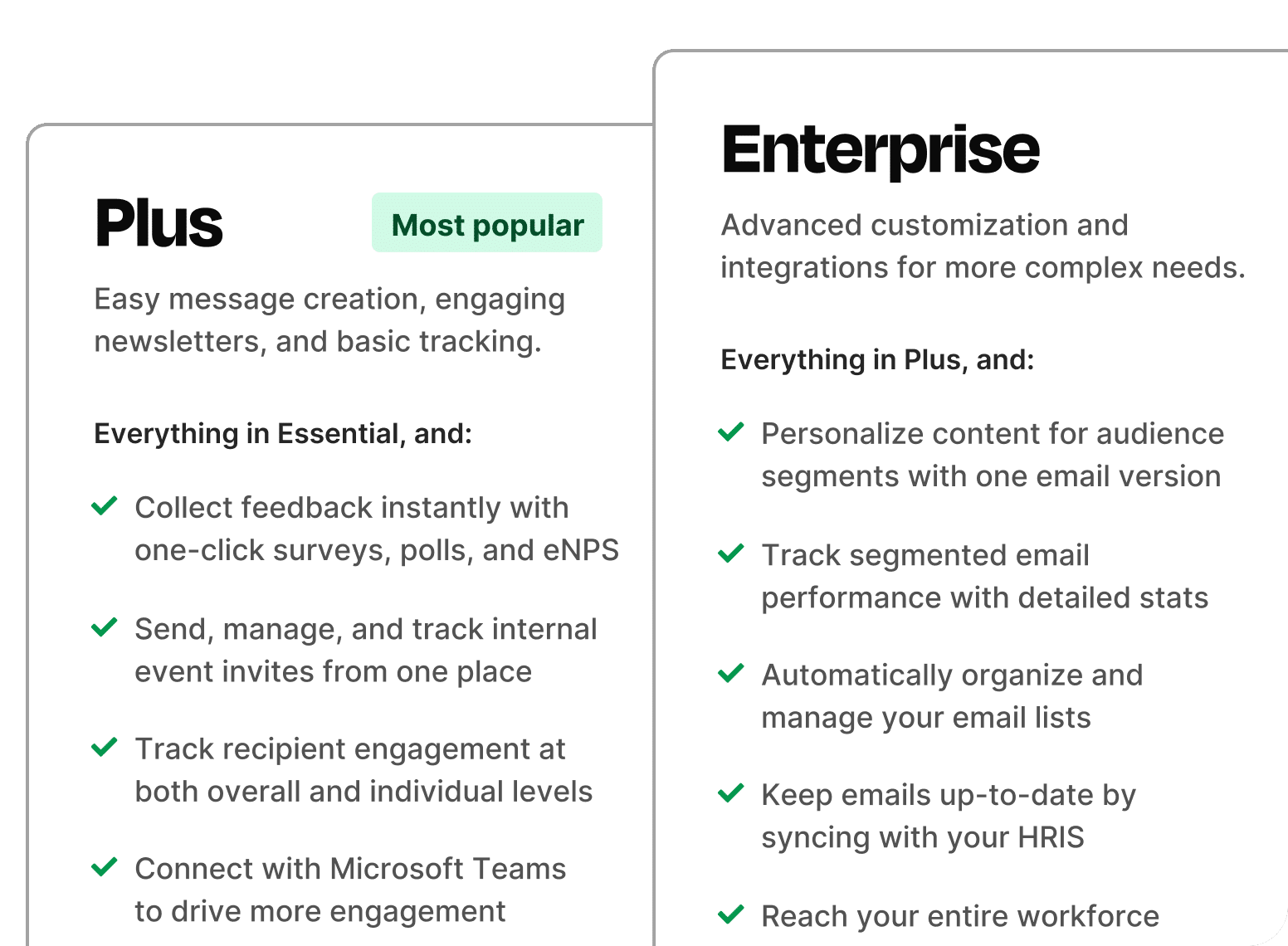
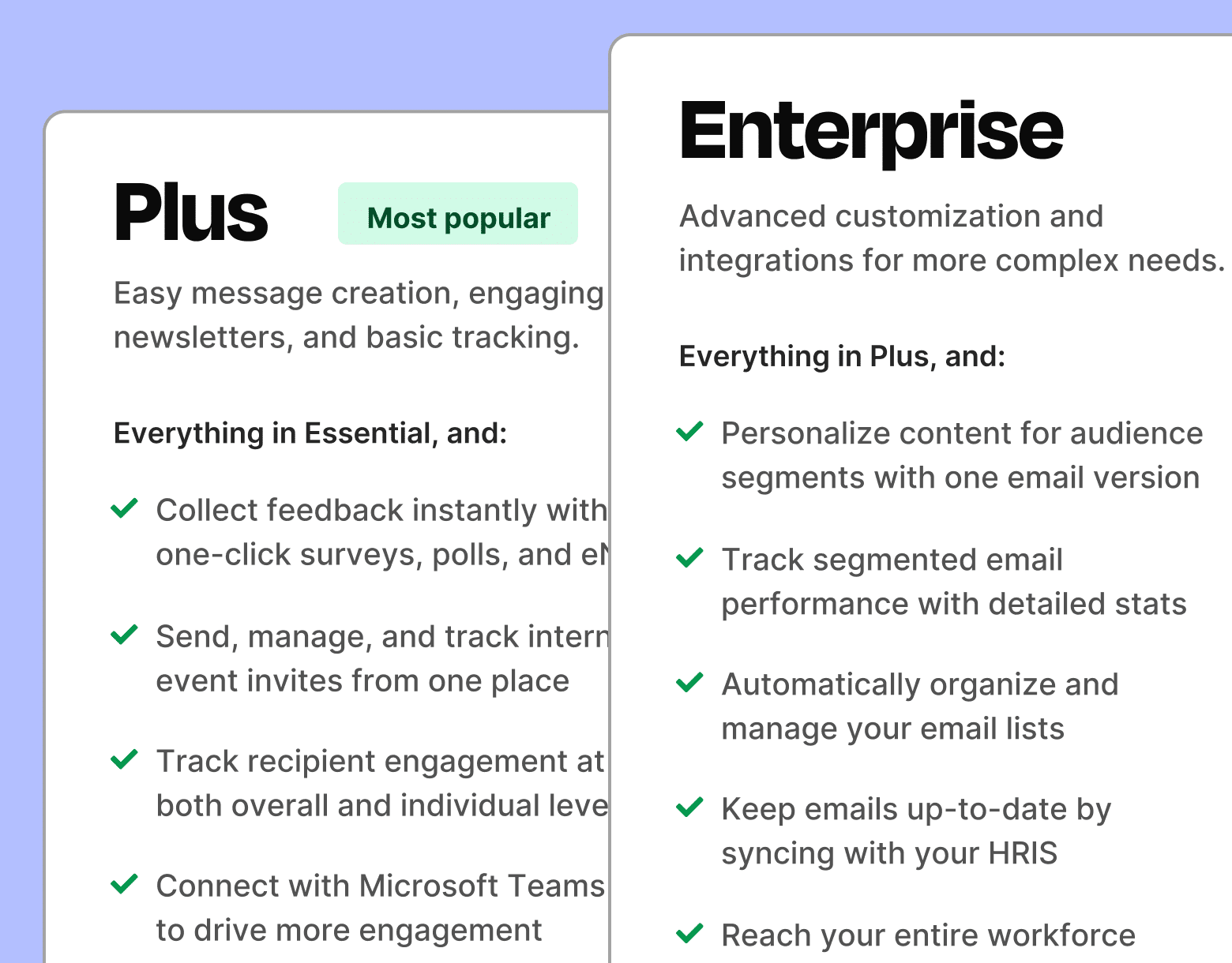
6. Company events
Employee engagement and employee relationships go hand-in-hand. The better your employees get along with each other, the stronger your company culture becomes.
Help your employees get to know one another better by hosting monthly, quarterly, or annual company events. We’ve already mentioned monthly town halls, but there are loads of company events you can try:
- end of quarter celebrations
- holiday parties
- lunch and learns
- bring your pet to work day
- trivia night
- sports games
- company sports teams
There are countless company event ideas that you can use to boost employee engagement and retention. Employees that are friends with their coworkers are more likely to stay at their jobs and get greater fulfillment from your business’ success.
7. Don’t overwhelm your employees
Not all employee engagement strategies are about adding things for your employees to do. Understanding how your employees relate to their work is important for avoiding work overload.
If your employees are struggling either professionally or personally, show them that their wellbeing is important to you and your business. Provide them what they need to get back on track, whether that be job-related counseling or even just a few days off for them to clear their head.
It’s important for your employees to feel supported by your organization, so ensure that you take their wellbeing seriously in your employee engagement and retention strategy.
8. Create an employee engagement strategy
Much of what we’ve mentioned so far can be planned and performed as part of an employee engagement strategy. An employee engagement strategy outlines your engagement goals, people involved, and measurement methods.
Planning your employee engagement initiatives ahead of time gives you numerous advantages. Cement the importance of your upcoming events to your employees by announcing them ahead of time. Gauge which events your employees prefer by collecting employee feedback, using employee engagement apps, and making changes based on their suggestions.
How can you know if you’re actually boosting employee engagement? Looking at internal email metrics can give you quantifiable data to build on. You can easily track your internal communications data to show if your engagement efforts have been successful.
Get powerful email analytics and reporting features
Know exactly who is opening and engaging with your employee communications and company newsletters.
Explore analytics & reporting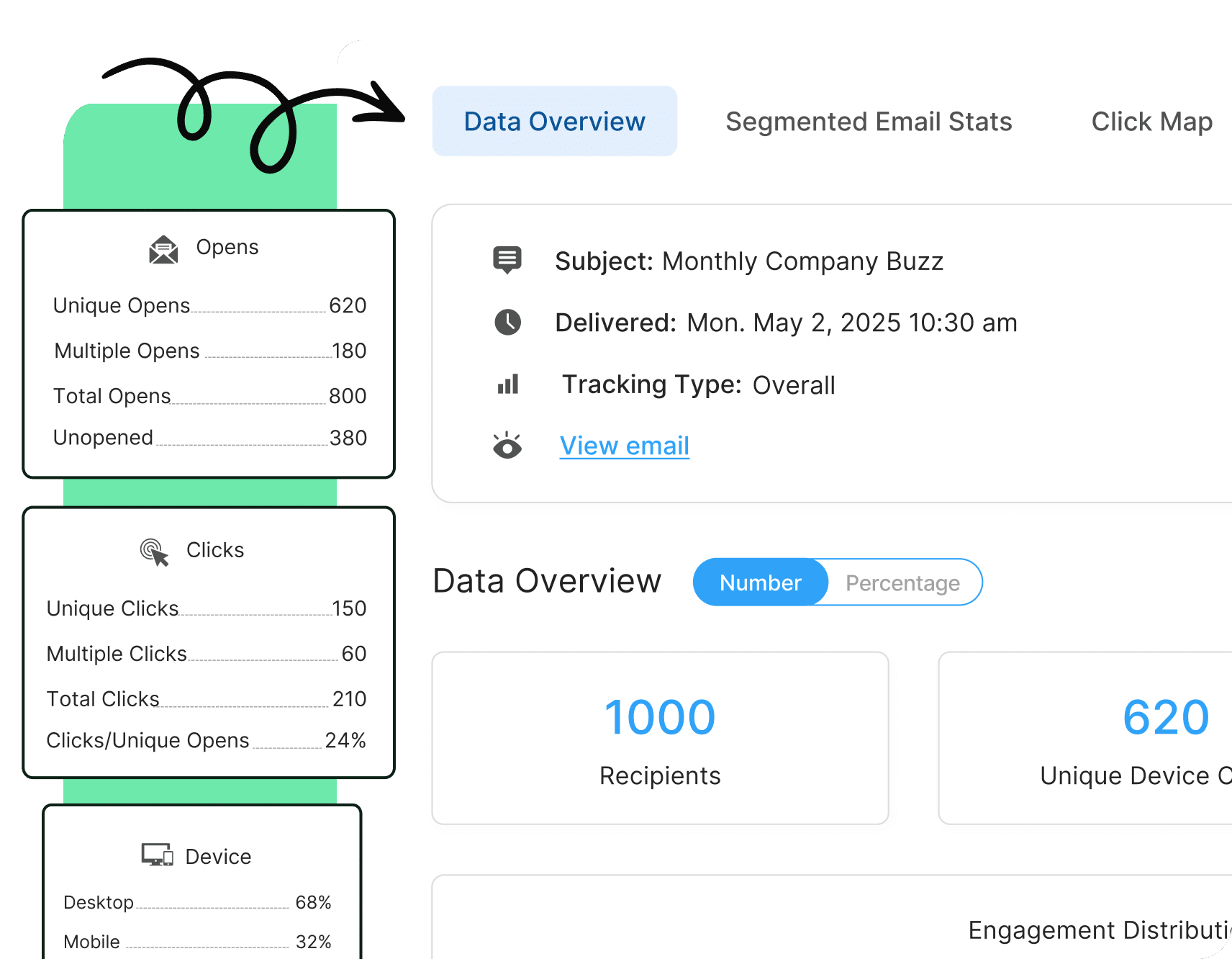
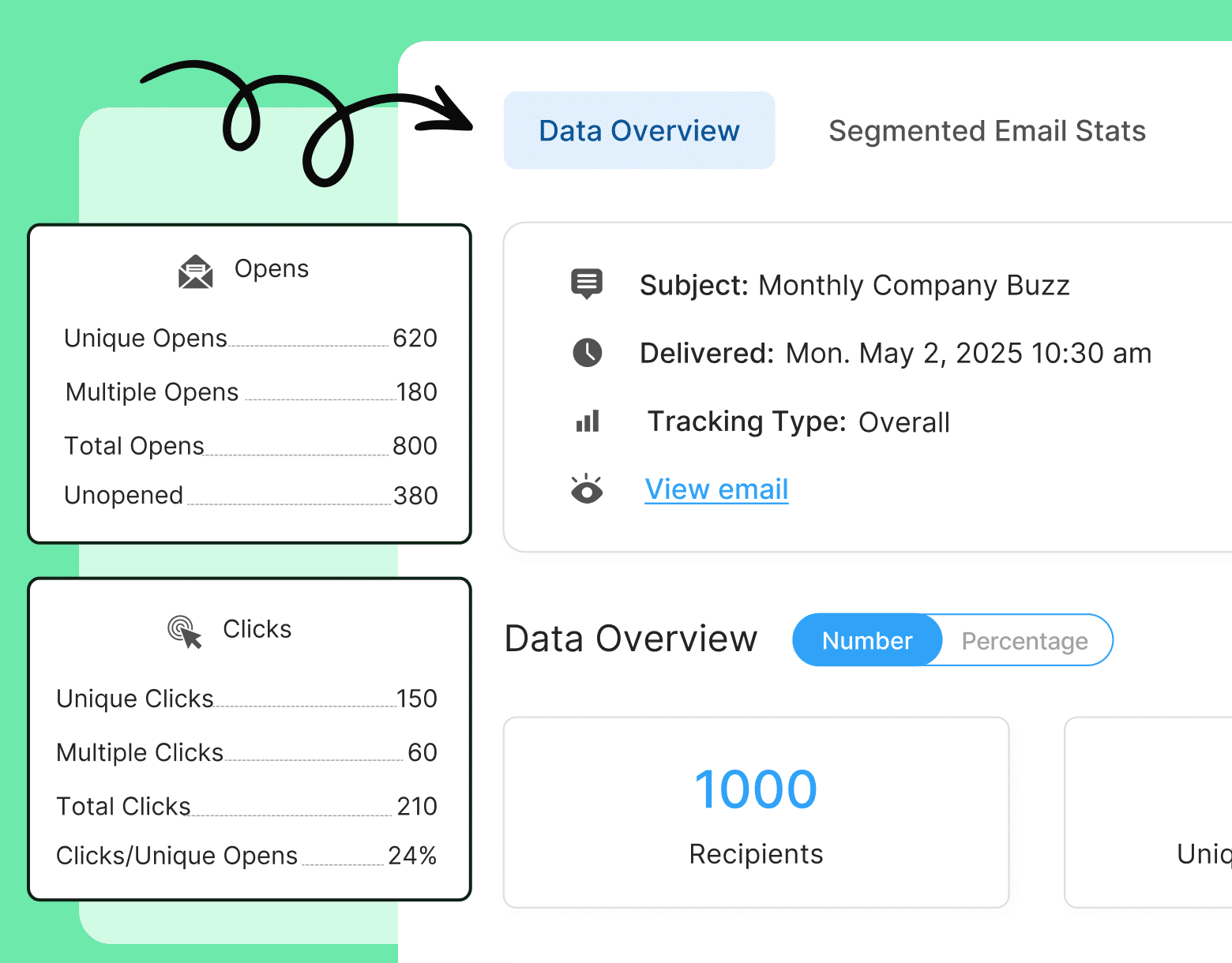
9. Track engagement via internal communications
You’ll know if your employee retention efforts are working if your company experiences lower than normal turnover after your efforts. But some periods of lower turnover don’t automatically mean you’re increasing employee engagement.
Use your internal communications to get a detailed look at your engagement picture. Track email metrics open rate, click-through rate, read time, and more to find the best times to send employee newsletters and maximize email engagement. This data can tell you where you need to focus your efforts, and if there are specific employees tuning out from your organization.
Within ContactMonkey, all your internal communications data is visualized within your analytics dashboard:
Analyze company performance, view employee engagement survey data, and read employee comments to pin down the unique issues that concern your employees. Knowing how your employees feel about your business will help you position them to stay and improve your employee retention.
You can also use ContactMonkey’s click maps feature to see exactly how your employees are interacting with your new process emails. Use this information to inform your email design so you can place important information where you know your employees will see it.
Does your organization have internal or external regulations around email privacy? Use ContactMonkey’s anonymous email tracking to gather email metrics while maintaining your employees’ privacy.
10. Keep employees informed of company news
Uncertainty breeds anxiety. Keeping your employees in the know about company issues that affect them is a quick and easy way to increase employee retention.
An internal company newsletter is a terrific way to create a centralized, consistent source of company information for your employees. There is loads of information you can use to create new employee newsletter ideas, and you can measure email newsletter engagement to get a sense of overall engagement.
Create and send email newsletters in a snap using ContactMonkey’s email template builder features. Start from scratch or choose from our library of newsletter templates to find one that works best with your company branding and style.
Take a look at these tips on how to better engage employees in the workplace.
Keep Your Employees Happy with ContactMonkey
Keeping employee retention high and turnover rates low is a full-time commitment. Your employees’ feelings about your business can change daily, which is it’s crucial to maintain employee engagement best practices to ensure you keep your top talent.
ContactMonkey’s all-in-one internal email tool makes it super easy to create, send, and track internal communications and measure employee engagement. Learn what really matters to your employees and give them the support they need to feel fulfilled at your organization.
Start proving employee engagement’s ROI by keeping employees engaged and happy with their current employer.
Interested in taking a data-based approach to employee retention? Book a free demo to see how ContactMonkey gives you everything you need to boost employee engagement and measure employee satisfaction.




